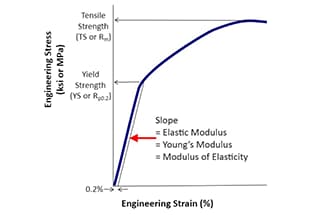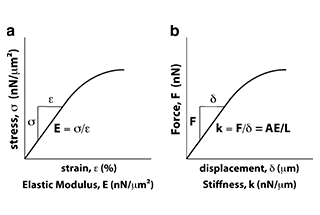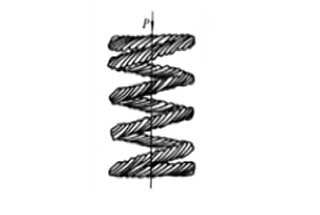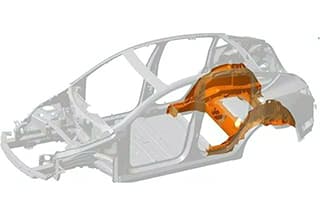
Have you ever wondered why some materials bend while others snap? This blog post explores the fascinating world of material properties, focusing on elasticity, stiffness, strength, and hardness. By the end, you’ll understand how these properties impact everything from machine parts to everyday objects.

Elastic modulus is a critical performance parameter in materials science and engineering.
While numerous parameters are used to characterize materials, elastic modulus, stiffness, strength, and hardness are among the most frequently utilized. However, these concepts are often misunderstood or conflated. Let’s examine these properties to better comprehend their relationships and distinctions.
Elastic modulus, also known as Young’s modulus, quantifies a material’s resistance to elastic deformation. A higher elastic modulus indicates a greater ability to withstand deformation under applied stress. Within the elastic range, the relationship between stress and strain is linear and proportional, adhering to Hooke’s law. The elastic modulus is defined as the ratio of stress to strain in this linear region.
As an intrinsic material property, elastic modulus reflects the strength of interatomic, intermolecular, or ionic bonds within the material’s structure. It is influenced by factors such as chemical composition, crystal structure, and temperature. Generally, the elastic modulus of a material decreases with increasing temperature. This principle is exploited in metalworking processes like forging, where heating parts prior to shaping reduces both the elastic modulus and yield strength, facilitating easier deformation compared to working at room temperature.
Understanding elastic modulus is crucial for material selection in engineering design, as it directly impacts a component’s stiffness, deflection under load, and overall structural performance. It also plays a vital role in predicting material behavior in various applications, from aerospace to civil engineering.

Heat treatment of metal materials encompasses a range of processes, including:
Bulk heat treatments:
Surface heat treatments:
These heat treatment processes can significantly alter the microstructure of the material, leading to substantial changes in mechanical properties such as:
However, the elastic modulus, also known as Young’s modulus, is primarily determined by the interatomic bonding forces within the material. These forces are inherent to the material’s composition and crystal structure, and are less affected by heat treatment processes.
The elastic modulus typically changes by only about 3-5% due to heat treatment, which is considered negligible for most engineering applications. This slight variation can be attributed to:
Given this minimal impact, engineers and materials scientists generally treat the elastic modulus as a constant value for a given material in practical applications. This approach simplifies calculations and material selection processes without significantly compromising accuracy.
It’s worth noting that while heat treatment may not substantially alter the elastic modulus, other factors such as temperature during use, severe plastic deformation, or significant changes in composition can have more pronounced effects on this property.


Stiffness
Stiffness is a critical mechanical property that quantifies a part’s resistance to elastic deformation when subjected to external forces. It is governed by two primary factors: the geometry of the part and the material properties. The geometry encompasses structural elements such as cross-sectional area, moment of inertia, and overall design, while material properties are primarily represented by the elastic modulus (Young’s modulus). For a given structural configuration, a higher elastic modulus correlates directly with increased stiffness.
In precision engineering applications, such as machine tool design, stiffness plays a pivotal role in maintaining operational accuracy. The spindle of a machine tool serves as an excellent example where stiffness is paramount. During operation, the spindle must maintain its dimensional stability under various loads to ensure consistent machining precision. Any elastic deformation of the spindle can lead to positional errors, surface finish irregularities, and overall reduced part quality.
When designing machine tool components like spindles, engineers must optimize both structural geometry and material selection. Advanced finite element analysis (FEA) techniques are often employed to simulate and predict the stiffness characteristics under various loading conditions. Materials with high elastic moduli, such as tool steels or ceramic composites, are frequently utilized. Additionally, innovative design features like ribbing, hollow shaft configurations, or hybrid material systems may be incorporated to enhance stiffness without excessive weight penalties.
It’s worth noting that while high stiffness is often desirable, it must be balanced with other design considerations such as weight, cost, manufacturability, and damping characteristics. In some cases, controlled flexibility might be intentionally designed into a system to absorb vibrations or accommodate thermal expansion.

Strength is a critical parameter used to assess the load-bearing capacity of a component or part within its operational context. This property is fundamental in determining the structural integrity and performance limits of materials under various stress conditions.
For brittle materials, such as cast iron or ceramics, we primarily utilize the ultimate tensile strength (UTS) or compressive strength to evaluate potential failure. These materials typically fail without significant plastic deformation, making the ultimate strength a crucial design criterion.
In contrast, for ductile or elastic materials like many steels and aluminum alloys, we employ a dual approach:
Engineers must consider both yield and tensile strengths when designing with elastic materials to ensure that components not only avoid permanent deformation under normal operating conditions but also maintain a sufficient safety margin against catastrophic failure.
Additionally, factors such as fatigue strength for cyclic loading, creep strength for high-temperature applications, and impact strength for dynamic loading scenarios may also be considered depending on the specific application requirements and environmental conditions.

Hardness is a fundamental property of materials that quantifies their resistance to localized plastic deformation induced by mechanical indentation or abrasion. In metallurgy and manufacturing, hardness testing involves applying a controlled force to a material’s surface using standardized indenters of various geometries (e.g., spherical, pyramidal, or conical). The resulting indentation’s size or depth is then measured to calculate the hardness value.
The relationship between hardness and a material’s other mechanical properties is complex but significant. Generally, hardness correlates positively with yield strength and ultimate tensile strength. Materials with higher yield strengths typically exhibit greater resistance to plastic deformation, resulting in higher hardness values. However, it’s important to note that hardness is not a direct measure of strength but rather an indicator of a material’s resistance to localized deformation.
Hardness values are influenced by several factors:
Various standardized hardness tests exist, including Brinell, Rockwell, Vickers, and Knoop. Each test is suited for specific materials or applications and provides values on different scales. Understanding the relationship between hardness and other material properties is crucial for material selection, quality control, and predicting component performance in manufacturing and engineering applications.
While elastic modulus and hardness are distinct material properties, there is indeed a complex relationship between them, particularly in metals and ceramics. Although they measure different aspects of material behavior, correlations can often be observed.
Elastic modulus, also known as Young’s modulus, quantifies a material’s resistance to elastic deformation under load. It is an intrinsic material property that reflects the strength of atomic bonding. Hardness, on the other hand, measures a material’s resistance to localized plastic deformation, typically through indentation.
In many materials, especially metals, a positive correlation exists between elastic modulus and hardness. This relationship stems from the fact that both properties are influenced by the strength of interatomic bonds. Materials with stronger atomic bonds tend to have higher elastic moduli and are often harder.
However, it’s crucial to note that this correlation is not universal or linear across all material classes. Factors such as crystal structure, grain size, and microstructural features can significantly influence hardness without necessarily affecting the elastic modulus to the same degree.
For instance, heat treatment processes like work hardening can substantially increase a metal’s hardness while having minimal impact on its elastic modulus. Conversely, some ceramic materials may exhibit high hardness but relatively low elastic modulus due to their unique bonding characteristics.
In practice, engineers and materials scientists often use empirical relationships between elastic modulus and hardness for specific material classes to estimate one property from the other. These relationships, while useful, should be applied cautiously and with an understanding of their limitations and the specific material context.








